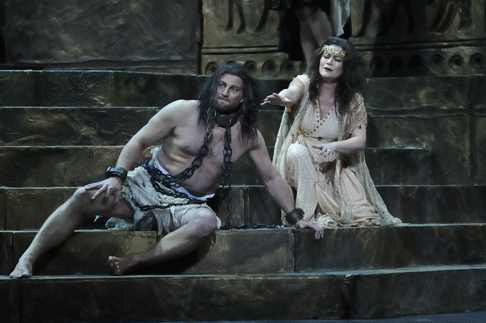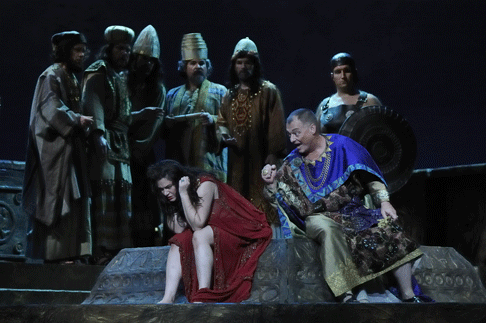01 Dec 2011
Salome, Manitoba Opera
Opera has never been an art form to hold anything back. But even within the genre itself, Salome is — literally — one tough, depraved act to follow.

Opera has never been an art form to hold anything back. But even within the genre itself, Salome is — literally — one tough, depraved act to follow.
Manitoba Opera’s new production of Richard Strauss’ staged tone poem sung in German (with English surtitles) took its viewers into the blackest heart of darkness as a daring choice to open its new season. Based on Hedwig Lachmann’s translation of Oscar Wilde’s play Salomé, the 110-minute production (no intermission) directed by MO general director/CEO Larry Desrochers featured an expanded Winnipeg Symphony Orchestra led by the company’ principal conductor/music advisor, maestro Tyrone Paterson. The three-show run held November 19 to 25, 2011 at Winnipeg’s Centennial Concert Hall notably marks only the company’s second staging of the 20th century classic in 23 years.
The gritty, one-act opera based on the New Testament story of the beheading of John the Baptist deals with incest, prophecy, and madness — and yes, ultimately, love. Young Princess Salome has become obsessed with prophet Jokannan who is imprisoned by her stepfather/uncle, King Herod. He, in turn, lusts for her and cajoles her to dance for him. She agrees only after he promises he will give her whatever she desires — in this case, the Baptist’s head on a silver platter.
Russian-born soprano Mlada Khudoley has performed the title role approximately a dozen times over the past 13 years. Her riveting portrayal displayed her impressive dramatic range that had her pounding her fists like a tempestuous teenager before morphing into a hell bent, vengeful woman on the brink of insanity. The US-based powerhouse’s well-paced vocal delivery allowed her to save her last breath — if it were possible — for her final declamatory “If you had seen me, you would have loved me” that is the impetus for this opera. Strauss’ dissonant, through-composed score proved no match for this dynamo, with her soaring voice effortlessly projecting over the knotty, Wagnerian-scale orchestration.
Tenor Dennis Petersen crafted his lecherous Herod, at times, as a sickeningly juvenile ruler who plays peek-a-boo with Salome during her erotic “Dance of the Seven Veils” choreographed by Brenda Gorlick. His penetrating voice grew more desperate as he lured his stepdaughter in “Dance for me, Salome,” later stamping his feet in a sudden, volatile outburst after the princess insists on her prize. His wife/sister-in-law Herodias sung by the incomparable Canadian mezzo-soprano Judith Forst sputtered as a long-suffering partner, attempting to pierce her husband’s growing obsession for Salome like a knife.
 lada Khudoley as Salome and Gregory Dahl as Jokanaan [Photo by R. Tinker courtesy of Manitoba Opera]
lada Khudoley as Salome and Gregory Dahl as Jokanaan [Photo by R. Tinker courtesy of Manitoba Opera]
Special mention must be made of Winnipeg baritone Gregory Dahl’s chain-shackled Jokanaan, who immediately asserted his booming presence even from the depths of the cistern with his first vocal entry, “After me, will come one.” The charismatic singer brought both requisite strength and nobility to the role, with his robust voice trembling with fury as he foretold the coming of the Son of Man.
Lyric tenor Michael Colvin performed Captain of the Guard, Narraboth with focused clarity, growing increasingly agitated as Salome ignores his advances for Jokanaan. Mezzo-soprano Marcia Whitehead’s Page set the stage for the entire tragedy to unfold with her ominous “Something terrible will happen.”
The chorus of five Jews (Mark Thomsen; Michel Corbeil; P.J. Buchan; Keith Klassen; David Watson) brought contrapuntal might to the stage with the two Nazarenes (Mark Bodden; Peter Klymkiw) telling of miracles.
 Mlada Khudoley as Salome and Dennis Petersen as Herod [Photo by R. Tinker courtesy of Manitoba Opera]
Mlada Khudoley as Salome and Dennis Petersen as Herod [Photo by R. Tinker courtesy of Manitoba Opera]
Several intriguing directorial choices underscored the love triangle — if you will — between Herod, Salome and Jokanaan, with Salome quietly slipping a veil into the cistern while also gravitating towards it during her famous striptease, creating multiple layers of sub-text. The closing image of Salome bathed in white light after being killed by Herod’s guards also suggested her own redemption (by love?); a purifying baptism of sorts that made her a sympathetic character to be pitied, not abhorred.
The production featured Boyd Ostroff’s set design created for the Opera Company of Philadelphia with a large, luminous moon radiating throughout the show, as well as blood red lighting effects by Bill Williams. Costumes designed by Richard St. Clair included jewel-encrusted robes for Herod and his wife and a series of voluminous veils for Salome’s seductive dance.
Salome is not an opera for the faint of heart — nor is it the safest box office draw. There are no jocular drinking songs or bands of dancing gypsies for levity. Salome’s chilling aria “Ah, you would not let me kiss your mouth” sung to the bloodied, severed head before she does just that still resonates with horror even in the 21st century. Salome remains a fiercely relentless opera that deserves to be seen by any serious opera lover. After nearly a quarter century hiatus, MO audiences were finally given that chance.
Holly Harris